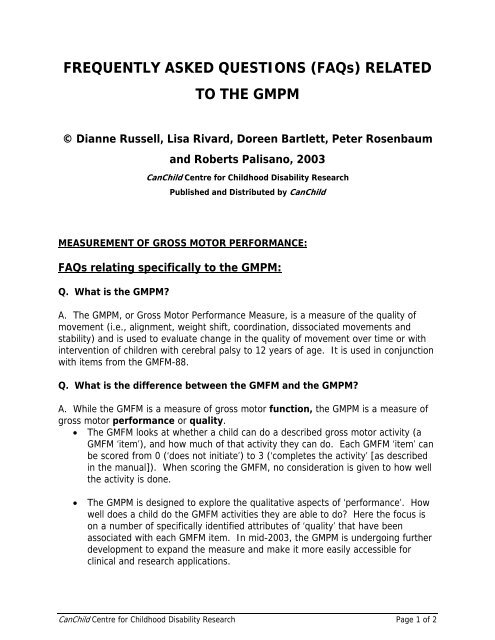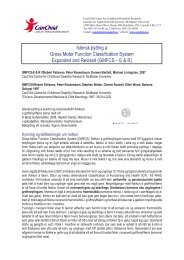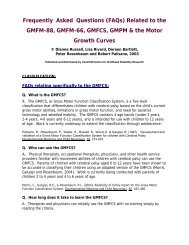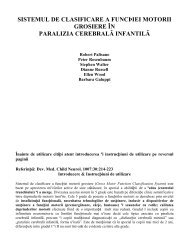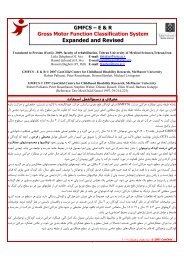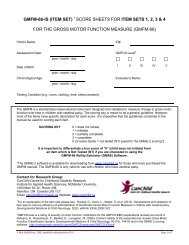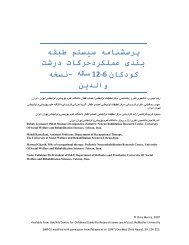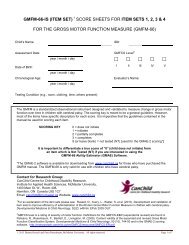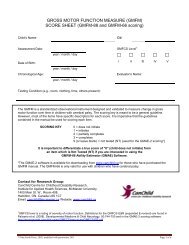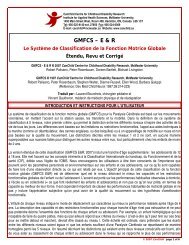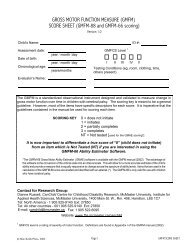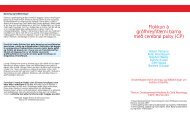GMPM - Motor Growth Measures - CanChild Centre for Childhood ...
GMPM - Motor Growth Measures - CanChild Centre for Childhood ...
GMPM - Motor Growth Measures - CanChild Centre for Childhood ...
You also want an ePaper? Increase the reach of your titles
YUMPU automatically turns print PDFs into web optimized ePapers that Google loves.
FREQUENTLY ASKED QUESTIONS (FAQs) RELATED<br />
TO THE <strong>GMPM</strong><br />
© Dianne Russell, Lisa Rivard, Doreen Bartlett, Peter Rosenbaum<br />
and Roberts Palisano, 2003<br />
<strong>CanChild</strong> <strong>Centre</strong> <strong>for</strong> <strong>Childhood</strong> Disability Research<br />
Published and Distributed by <strong>CanChild</strong><br />
MEASUREMENT OF GROSS MOTOR PERFORMANCE:<br />
FAQs relating specifically to the <strong>GMPM</strong>:<br />
Q. What is the <strong>GMPM</strong>?<br />
A. The <strong>GMPM</strong>, or Gross <strong>Motor</strong> Per<strong>for</strong>mance Measure, is a measure of the quality of<br />
movement (i.e., alignment, weight shift, coordination, dissociated movements and<br />
stability) and is used to evaluate change in the quality of movement over time or with<br />
intervention of children with cerebral palsy to 12 years of age. It is used in conjunction<br />
with items from the GMFM-88.<br />
Q. What is the difference between the GMFM and the <strong>GMPM</strong>?<br />
A. While the GMFM is a measure of gross motor function, the <strong>GMPM</strong> is a measure of<br />
gross motor per<strong>for</strong>mance or quality.<br />
• The GMFM looks at whether a child can do a described gross motor activity (a<br />
GMFM ‘item’), and how much of that activity they can do. Each GMFM ‘item’ can<br />
be scored from 0 (‘does not initiate’) to 3 (‘completes the activity’ [as described<br />
in the manual]). When scoring the GMFM, no consideration is given to how well<br />
the activity is done.<br />
• The <strong>GMPM</strong> is designed to explore the qualitative aspects of ‘per<strong>for</strong>mance’. How<br />
well does a child do the GMFM activities they are able to do? Here the focus is<br />
on a number of specifically identified attributes of ‘quality’ that have been<br />
associated with each GMFM item. In mid-2003, the <strong>GMPM</strong> is undergoing further<br />
development to expand the measure and make it more easily accessible <strong>for</strong><br />
clinical and research applications.<br />
<strong>CanChild</strong> <strong>Centre</strong> <strong>for</strong> <strong>Childhood</strong> Disability Research Page 1 of 2
Q. Who can use the <strong>GMPM</strong>?<br />
A. The test developers identify the <strong>GMPM</strong> as appropriate <strong>for</strong> use by pediatric physical<br />
and occupational therapists who are experienced in working with children with<br />
neuromotor impairments and familiar with the administration guidelines outlined in the<br />
manual.<br />
Q. Has there been any further work on the <strong>GMPM</strong> since its initial<br />
development?<br />
A. As of the summer of 2003, there is work being done by Virginia Wright (Bloorview<br />
MacMillan Children’s <strong>Centre</strong>) to build on the feedback received by users of the <strong>GMPM</strong>.<br />
Consensus methods are being used to expand the number of GMFM items tested in the<br />
Stand and Walk Dimensions to look at quality and to do further reliability and validity<br />
testing of the expanded <strong>GMPM</strong>.<br />
Q. How can I obtain a copy of the original <strong>GMPM</strong> manual?<br />
A. For in<strong>for</strong>mation regarding how to obtain a copy of the original <strong>GMPM</strong> manual, please<br />
contact Dr. William Boyce, Social Program Evaluation Group, McArthur Hall, Queen's<br />
University, Kingston Ontario, K7L 3N6; by fax at (613) 533-2556, or by email at<br />
spegmail@educ.queensu.ca. In<strong>for</strong>mation about the expanded version of the <strong>GMPM</strong> can be<br />
obtained from Virginia Wright by email at vwright@bloorviewmacmillan.on.ca.<br />
<strong>CanChild</strong> <strong>Centre</strong> <strong>for</strong> <strong>Childhood</strong> Disability Research Page 2 of 2


